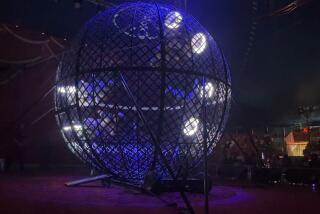Mashed-up ‘Mindfreak’
LAS VEGAS — Criss ANGEL seemed at once exhausted and totally keyed up, happy but sad, frustrated yet full of characteristic bluster, and more than anything else, mad.
Minutes after the curtain had fallen on the debut performance last month of “Criss Angel: Believe,” his Cirque du Soleil-produced multimedia magic extravaganza that is scheduled to run for the next 10 years at the Luxor Hotel & Casino, the magician settled into a sofa in his Olde English-meets-goth-decorated dressing room and tried to make sense of his jumble of emotions.
The show’s “soft opening” had been intended to help fine-tune “Believe” in the buildup to its official unveiling on Halloween. And by rights it should have been the end of the rainbow for Angel, the fruition of a passion project for the rock-star-famous bad boy illusionist and master escape artist -- a celebrity-canoodling tabloid mainstay who also directs, co-produces and stars in the “street magic” series “Mindfreak” on A&E.; But with the night’s performance marred by technical glitches and the omission of two significant illusions, he felt it had not been all it could be. (Especially contrasted against Angel’s 2007 press conference to announce “Believe,” when he said it would redefine “what magic is and can be.”)
“The audience was obviously entertained by it,” he said, matter of factly. “They experienced something we’re offering that no other show is offering. But from a technical standpoint, because of the way I am, a perfectionist. . .
“I think we’ve got a lot of work ahead of us,” he said.
A slow-developing routine
By ANGEL’S estimation, he spent 15 years prepping the show, innovating groundbreaking “demonstrations” (he never refers to his illusions as “magic tricks”), suffering setbacks and myriad sour deals before making good on his original idea. The highly technical show features a surrealistic mash-up of death-defying stunts, animatronic rabbits, dancers in macabre costumes, dizzying filmic special effects, aerial acrobatics and, of course, magic.
Not the kind of thing you’d necessarily associate with a guy who created his brand identity dangling, impaled by giant fishhooks from a helicopter; getting run over by a steamroller in a bed of broken glass; and surviving a detonated crate of C-4 explosive.
After he tried to develop the show for a Broadway run and with various other casinos, “Believe” finally took shape when he entered into a partnership with Cirque du Soleil and the Luxor’s parent company, MGM Mirage Resorts, which sunk a reported $100 million into the production. The Long Island-born magician is credited as its “co-writer, illusions creator and designer, original concept creator and star.”
“This show is about my life,” Angel said. “It’s ‘Alice in Wonderland.’ It’s ‘The Wizard of Oz.’ ‘Mindfreak.’ It’s about the demons in my head, the good that’s out there, the angels and love and lust -- all that stuff mixed up.”
Empirically speaking, “Believe” also exists as the merger of two high-profile brands: the man considered the most forward face of modern magic, a burgeoning entertainment mogul in his own right (he is developing a quintet of new TV shows, a movie and recently launched a streetwear line) and the cultural juggernaut of Cirque, whose Las Vegas-based productions have come to dominate nongambling entertainment in Sin City.
Cirque has never put its clout behind an individual performer this way before. And the troupe made a counterintuitive choice in hiring “Believe’s” co-writer and director Serge Denoncourt to bring it to the stage. “I’m well known in Quebec to be stubborn and hands-on and a control freak,” Denoncourt said. “As well, everybody knows I hate magic. I’m trying to direct a show for people who love it but also for people like me who hate magic.”
Yet with just days until the show’s grand opening, with more than $5 million in advance tickets sold, there still seems to be a fundamental disconnect between Angel and Cirque’s top brass about precisely what the show is supposed to be -- and, more important, who deserves credit. Gilles Ste-Croix, Cirque du Soleil’s senior vice president for creation, sounded determined to put a different spin on Angel’s achievements.
“It’s a Cirque show where he is the main character,” Ste-Croix said by phone from Montreal last month. “We used this man who has the following of a star, but in our scenario. It’s not MGM with Criss Angel, it’s MGM with Cirque du Soleil. Because he is the main artist, we had him participate with input.”
To underscore his Cirque-centric viewpoint, Ste-Croix added: “Maybe, you know, if Lance Burton or David Copperfield had said, ‘We want to do a show,’ we would have considered it. We thought about the opportunity with Criss and said, ‘We can do this.’ It’s as simple as that, how we ended up with Criss on the marquee.”
Never mind that until Ste-Croix began suggesting otherwise, Angel -- not Cirque -- had been positioned as the show’s headlining draw. To wit, a 43,000-square-foot billboard of the “Mindfreak” star’s face stares up from a side of the pyramid-shaped Luxor.
Backstage, Angel bristled at the characterization. Turns out Ste-Croix made similar remarks to a local newspaper that happened to be unfolded in the magician’s lap.
“That’s not the case,” he said, looking to a coterie of managers, publicists, lawyers and illusion specialists in his room for confirmation.
“We need to have a conversation with Mr. Gilles Ste-Croix.”
The elusive illusionist
TO THE extent Angel is famous beyond his core fans (who call themselves “The Loyal”), he remains a mystery wrapped inside a nu-metal-loving, motorcycle-riding, distressed-denim-wearing enigma. As someone whose business is “lying to people,” as he explains, the magician is very con- trolling of his image. And there are scores of YouTube videos that attempt to debunk Angel’s ability to freak minds.
Peering out from behind his curtain of emo hair, he routinely levitates between buildings and makes Lamborghinis and elephants disappear on “Mindfreak.” But it’s his more brutal illusions that seem to win hearts and minds: being smashed through a brick wall by a muscle car, regurgitating razor blades and dental floss to make a necklace, impaling himself on a spike-tipped fence.
“I consider myself a general practitioner,” Angel explained of his magic this past summer, before a taping in Hollywood. “I’m not the most talented person in the world. But what I pride myself on is being creative. I’m pretty good at coming up with new concepts. Just dreaming. Trying to think like a kid with no boundaries. I try to think visually about what I want to accomplish and then work backwards to think what methods could make that happen.”
Considered another way, if David Blaine represents a streetwise indie rock approach to magic and David Copperfield is a mainstream, blue-chip brand, Angel, 40, must be the milieu’s Marilyn Manson: A performer both beloved and reviled who never triggered a visceral reaction he didn’t like.
“He’s very cutting-edge, he wants to take you to a different place in magic,” said Dale Hindman, former president of the Academy of Magical Arts. “He’s using some of the same techniques as traditional magic but dresses them up differently and sometimes for shock value. Some people want ‘pure’ magic and don’t like [Angel’s] while some have great admiration and respect for him. Our view in the community is that he’s got the name of magic out there. It’s a positive thing.”
“He’s reenergized magic,” said Jeff McBride, a friend of Angel’s who was named Magician of the Year by the Magic Castle. “Many people see his success as a boon for all of us.”
As the aphorism goes, you can tell a lot about a man from the company he keeps. Angel’s the designated BFF to a number of raffish rock stars -- Tommy Lee of Motley Crue and Korn singer Jonathan Davis among them -- the blinged-out, bandanna-wearing figure flashing cryptic hand signs in paparazzi photos. And the magician’s supposed romantic exploits, as recorded in the tabloid press, have had him variously linked with Paris Hilton, Lindsay Lohan, Britney Spears and Pamela Anderson. (Lately, innuendo has him hooked up with Holly Madison, one of Hugh Hefner’s Playmate harem of girlfriends on the E! network show “The Girls Next Door” -- a rumor she has discredited.) Whether any of them have been touched by an Angel or not, his reputation as a celeb lothario persists. “You can’t believe any of that,” he said, inadvertently evoking the name of his show.
Then there’s the Miss USA incident. In April, after Angel’s then girlfriend, Miss Nevada Veronica Grabowski, did not win the nationally televised beauty pageant in Las Vegas, the “Mindfreak” star reportedly leapt up and made an obscene gesture to the camera. Afterward, in a widely cited exchange, he threatened local Las Vegas columnist Norm Clarke (who wears an eye patch): “Don’t ever write another word about me or you’ll need an eye patch over your other eye.”
Angel vigorously denies both encounters (although Clarke and other sources have confirmed Angel threatened him). “People perpetuate things because it brings the spotlight to them,” he said at the Luxor in July. “There is so much that is unbelievable that I see on so many levels. But what happens is, if I say, ‘It’s not fair,’ you give it more fuel and it gets blown out of proportion.”
About his social life, Angel framed the debate around depth of perception. “Pamela Anderson is a friend of mine. I went to her birthday party, I was there for maybe an hour. And I’m dating her now? This is what happened: I was sitting there talking to her, someone takes a picture from here and it looks like we’re kissing. A good friend of mine is Tommy Lee! He has kids with her! Morally, I would never do that.”
Still, Angel’s uneasy peace with the media is a featured component of “Believe.” There’s a sequence involving a horde of paparazzi that surrounds Angel, invasively photographing him until he busts out some magic to clear the scene. “That’s a moment where we try to talk about his life,” said Denoncourt. “It’s a dreamy, nightmare kind of thing.”
Criss Angel: Believe quoting audience members who had flown in from as far away as London to see a preview. performance of “Believe.” “The verdict by many?” Elfman wrote. “Creatively, ‘Believe’ is a possibly unsalvageable ‘waste of time’ and a ‘dead end’ that literally bored some audience members to sleep.”
Even before the early negative fan commentary
A magician with ambition
“CRISS ANGEL: Believe” is the crystallization of two long-held dreams. In 1993, the guy on the marquee was basically nobody, a wannabe rock star-cum-magician named Christopher Sarantakos. Living with his parents, performing a hybrid rock-magic act at children’s birthday parties and corporate events, the future Criss Angel began collating his ideas about a show featuring magic as something other than “hokey novelty about shoving girls in boxes” and maneuvered to “catapult it into the 21st century so that magic garners the same respect as cinema and music.”
Long on ambition and short on cash, he began building mock-ups for his future illusions out of cardboard, duct tape and plastic bags. In 2001, Angel finally hit it big with his hit off-Broadway show “Mindfreak,” a professional Hail Mary his mother mortgaged the family home to pay for. Around the same time, Cirque du Soleil’s founder, Guy Laliberte, decided to branch the French-Canadian performance troupe out from its core identity as a circus to encompass magic.
“It’s been a dream of Guy to do a magic show for the last 20 years,” said Denoncourt, co-writer and director of “Believe,” a veteran of more than 80 productions in his native Quebec, including classics by Chekhov, Shakespeare and Bertolt Brecht.
“We had tried in ’96 to build a magic show in Montreal,” Ste-Croix pointed out. “We had a magician from France -- I can’t remember his name. His tricks were good. But it’s not only about tricks. Magic has to be carried by someone you can believe has the power to do these incredible things. Criss Angel is a character that can carry a show.”
Backstage after the debut “Believe” performance, Denoncourt took issue with Ste-Croix, heaping credit on Angel for concocting the show’s overall narrative premise, characters and illusions.
“You are not an employee of Cirque du Soleil, I am,” Denoncourt said, looking directly at Angel. “I did that show with Criss Angel. He wrote it, I rewrote it with him. I didn’t impose anything on him. It was teamwork.”
Angel’s trailblazing within the prescribed infrastructure of Cirque du Soleil is hardly a sure bet. Early buzz from preview shows -- which Cirque productions rely upon to diagnose problems and implement sweeping changes right up until the grand opening -- has been withering.
On Sept. 29, Las Vegas Review-Journal reporter Doug Elfman published a story quoting audience members who had flown in from as far away as London to see a preview performance of “Believe.” “The verdict by many?” Elfman wrote. “Creatively, ‘Believe’ is a possibly unsalvageable ‘waste of time’ and a ‘dead end’ that literally bored some audience members to sleep.”
Even before the early negative fan commentary started, Jeff McBride pointed out expectations on the Vegas Strip were sky high for “Believe.” “This must deliver the greatest magic show that’s ever been. It’s built up to this,” McBride said. “The last big show in the showbiz capital of the world was Siegfried & Roy” -- whose run was cut short when a white tiger mauled Roy Horn in 2003. “It either tops that [show] or it fails,” the magician continued.
Would you ‘Believe’?
Scheduled TO be performed 4,600 times in the Luxor’s 1,600-capacity theater (which has been revamped with a gilded steampunk aesthetic), “Believe” begins with a set piece involving “Mindfreak” before switching gears. It follows a Victorian gentleman (Angel) who must navigate surrealistic, sometimes sexually aggressive tableaux vivant peopled by monsters and dolls, lovers and killing machines. As he searches for love and cheats death, the magician finds time to escape a straitjacket while suspended dozens of feet above the audience, appears to allow a dancer to crawl directly through his torso, get cut in half by a giant buzz saw and even be pulled out of a giant top hat by the show’s comedic leitmotif, a rabbit.
Dance is a central component of the spectacle, choreographed by Wade Robson, the Emmy-winning pop-dance wunderkind who’s best known for choreographing segments on several seasons of “So You Think You Can Dance” and Britney Spears’ “I’m a Slave 4 U” video. Over a year-and-a-half-long process, he vetted “Believe’s” hundreds of hopefuls down to the final 14 who appear onstage.
However, Robson had cold feet about the project initially, until Denoncourt flew to New York to personally assure him there would be “nothing ‘cute’ about this show.”
“I knew it was Criss Angel. I’m thinking, ‘Magic? Dance? This coud be really cheesy,’ ” Robson said. “When you think of a magic show with dance, you think, ‘Ta-da!’ and the magician leaves and a couple of dancers come on and do a number. But none of the illusions happens just for the sake of the ‘wow’ factor. They happen to move the story along.”
In July, Denoncourt summed up a certain battle of showbiz wills surrounding the production that seems prophetic in light of Ste-Croix’s jabs about Angel. “There’s a lot of ego in the building,” Denoncourt said. “But we managed to be kind and respectful to each other. The biggest challenge on a day-to-day basis was that.”
But “Believe” -- for which tickets are between $59 and $160 -- is up against other storm fronts as well. There’s Angel’s workload: performing two shows a day, five days a week for a decade in addition to conceiving and performing illusions for “Mindfreak.” (“I’m a workaholic,” he said.) And concerns persist that the economic crisis will continue to wither Las Vegas’ economy even as Cirque moves forward on developing a new production based around Elvis that is scheduled to open at the Aria Hotel next year.
“Believe’s” grand opening has been pushed back twice because of “technical difficulties,” and Angel and Denoncourt have repeatedly shot down rumors about their infighting, but the magician seemed constitutionally incapable of voicing apprehension about failure.
“I don’t fear death. So anything that happens is just something you learn from,” he said. “We want this show to be a celebration of life: its ups, its downs and in betweens. The spectrum. That’s what we’re putting into it. We want that 90 minutes to be deep, poetic and beautiful.”
--
More to Read
The biggest entertainment stories
Get our big stories about Hollywood, film, television, music, arts, culture and more right in your inbox as soon as they publish.
You may occasionally receive promotional content from the Los Angeles Times.











